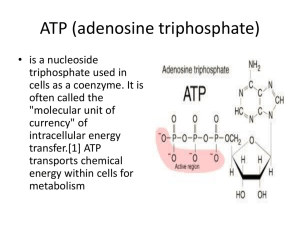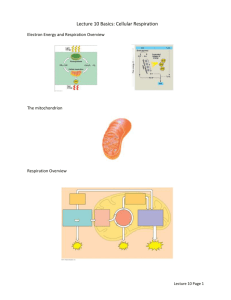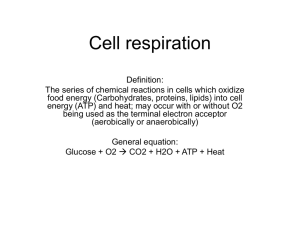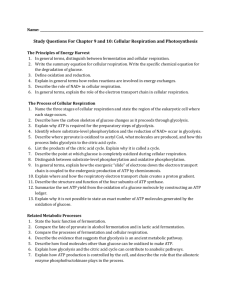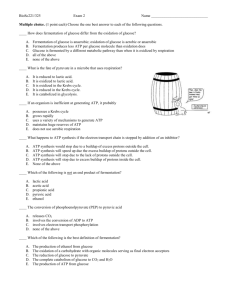Honors Cellular Respiration Practice Questions
advertisement
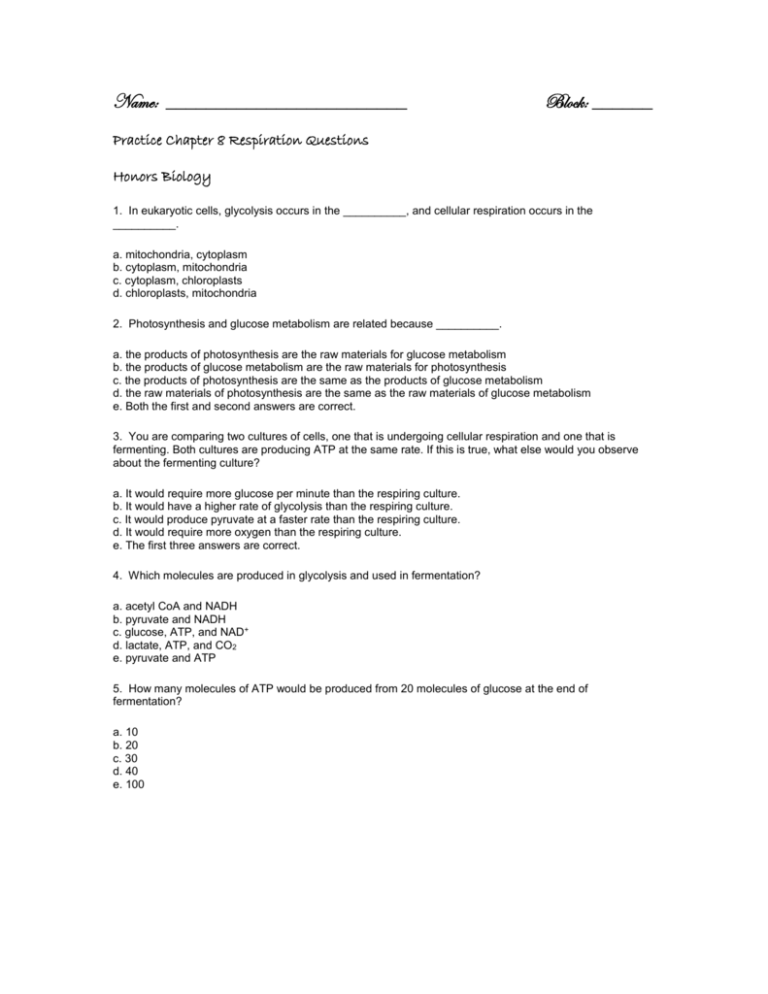
Name: ________________________ Block: ______ Practice Chapter 8 Respiration Questions Honors Biology 1. In eukaryotic cells, glycolysis occurs in the __________, and cellular respiration occurs in the __________. a. mitochondria, cytoplasm b. cytoplasm, mitochondria c. cytoplasm, chloroplasts d. chloroplasts, mitochondria 2. Photosynthesis and glucose metabolism are related because __________. a. the products of photosynthesis are the raw materials for glucose metabolism b. the products of glucose metabolism are the raw materials for photosynthesis c. the products of photosynthesis are the same as the products of glucose metabolism d. the raw materials of photosynthesis are the same as the raw materials of glucose metabolism e. Both the first and second answers are correct. 3. You are comparing two cultures of cells, one that is undergoing cellular respiration and one that is fermenting. Both cultures are producing ATP at the same rate. If this is true, what else would you observe about the fermenting culture? a. It would require more glucose per minute than the respiring culture. b. It would have a higher rate of glycolysis than the respiring culture. c. It would produce pyruvate at a faster rate than the respiring culture. d. It would require more oxygen than the respiring culture. e. The first three answers are correct. 4. Which molecules are produced in glycolysis and used in fermentation? a. acetyl CoA and NADH b. pyruvate and NADH c. glucose, ATP, and NAD+ d. lactate, ATP, and CO2 e. pyruvate and ATP 5. How many molecules of ATP would be produced from 20 molecules of glucose at the end of fermentation? a. 10 b. 20 c. 30 d. 40 e. 100 6. What is the product of the fermentation of sugar by yeast in bread dough that is essential for the rising of the dough? a. lactate b. ATP c. ethanol d. CO2 e. O2 7. What is the role of fermentation in glucose metabolism? a. Fermentation extracts the maximum ATP from glucose. b. Fermentation is necessary under aerobic conditions. c. Fermentation regenerates NAD+ under anaerobic conditions. d. Fermentation allows the cell to use glucose under aerobic conditions. 8. What role is played by the electron transport chain during cellular respiration? a. The electron transport system takes energy from the high-energy electrons brought by electron carriers (e.g., NADH) and uses it to pump hydrogen ions against their concentration gradient from the matrix into the intermembrane compartment. b. The electron transport system allows hydrogen ions to diffuse down their concentration gradient from the intermembrane compartment to the matrix. c. The electron transport system produces ATP. d. all of the above 9. Suppose that the reactions of mitochondria of a green plant were completely inhibited. What process would immediately stop? a. glycolysis b. fermentation c. photosynthesis d. ATP production e. lactate production 10. In eukaryotic cells, pyruvate produced by glycolysis is transported into the mitochondrial matrix, where __________. a. enzymes for the Krebs cycle break down the pyruvate, producing CO2 as a waste product b. the electron transport system recombines pyruvate molecules to produce glucose c. enzymes for the Krebs cycle convert the pyruvate into alcohol or lactate d. the electron transport system breaks down the pyruvate, producing CO2 as a waste product 11. In eukaryotes, during the process of chemiosmosis, ATP is produced as hydrogen ions move from __________ to __________, passing through __________. a. the intermembrane compartment, the matrix, an ATP synthase b. the matrix, the intermembrane compartment, an ATP synthase c. the cytoplasm, the matrix, the electron transport system d. the matrix, the cytoplasm, the Krebs cycle 12. What products of the Krebs cycle feed the electron transport chain? a. NADH and FADH2 (flavin adenine dinucleotide) b. pyruvate and acetyl CoA c. fructose bisphosphate d. carbon dioxide 13. How is electron transport related in chloroplasts and mitochondria? a. Electron transport is used in each case to synthesize ATP, although the electron donors and final electron acceptors differ in the two systems. b. They have no similarities at all. c. The chloroplast system depends on intact membranes while the mitochondrial doesn't. d. Only the mitochondrial electron transport system can synthesize ATP. 14. What is the final electron acceptor in the electron transport chain? a. NADH b. carbon dioxide c. acetyl CoA d. oxygen 15. Why should anyone care about the importance of ATP production? a. Even though the production of ATP occurs within individual cells, a multicellular organism requires the energy produced to carry out vital functions essential for survival. Any organism would quickly die without constant production of ATP. b. The memorization of foreign-sounding biochemical terms was required by the instructor. c. Understanding glycolysis and cellular respiration permits insights into how different organisms manage their energy needs in different environments. d. Both the first and third answers are correct.



